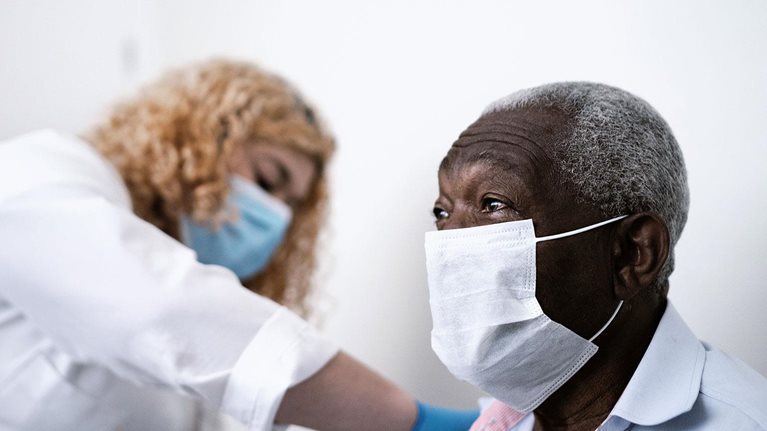As COVID-19 continues to spread throughout the country, the 46 million Americans residing in rural counties bear an increasing burden from the pandemic, with viral transmission and death rates outpacing those of urban communities.
Unless stakeholders act with extraordinary speed in the months ahead, the impact on lives and livelihoods in rural communities will worsen.
In this article, we look closely at the impact of COVID-19 on rural communities leveraging data and analytics from Carrot Health, which provides consumer insights and social determinants of health scoring and monitoring for the healthcare industry. Specifically, we discuss four factors that appear to be contributing to the spread of the virus: underlying health status, socioeconomic vulnerability, access to care, and compliance with public health guidance.
Addressing these rural healthcare challenges will require a multifaceted approach: stakeholders should consider both healthcare delivery and broader social determinants of health to transform healthcare in rural areas. We suggest near-term actions to save lives and safeguard livelihoods in rural communities as they manage the pandemic on three fronts: treating serious COVID-19 cases, curbing further spread of the virus, and addressing mental health and social needs.
COVID-19’s disproportinate spread in rural communities
At the beginning of the COVID-19 pandemic, cases and deaths were concentrated in large urban centers. However, as the pandemic progressed, rural communities began to bear a higher burden from the virus (Exhibit 1). Rural residents account for 14 percent of the total US population but are 16 percent of all new COVID-19 deaths through February 2021. In that same time period, rural communities have experienced 175 deaths per 100,000 residents, compared with 151 deaths per 100,000 residents for urban communities. Death rates have risen in rural communities most months since March 2020.1

The pandemic has also shed light on longstanding racial and ethnic inequities in health and healthcare.2 As of February 2021, highly diverse counties have experienced 258 deaths per 100,000 residents, compared with 161 deaths per 100,000 residents for less diverse rural counties, that is, a 60 percent higher death rate.34 This discrepancy in mortality is higher than the discrepancy in urban areas, where, on average, highly diverse communities have reported a 13 percent higher death rate per 100,000 residents than less diverse communities.5
COVID-19 and highly diverse rural communities
The COVID-19 pandemic has cast a spotlight on racial and ethnic health inequities. While there is a growing body of research on the disproportionate impact of the COVID-19 pandemic on racial and ethnic minorities,67 the inequities in racially and ethnically diverse rural communities have largely been overlooked. It is worth noting that highly diverse rural communities—that is, those in which at least 33 percent of the population are people of color—represent 14 percent of the rural population and are home to 6.4 million people.8
With over half of the American Indian and Alaska Native (AI/AN) population living in rural communities and more than two-thirds in counties including or adjacent to tribal lands and reservations, it is important to note that the AI/AN population has the country’s highest COVID-19 hospitalization rate, at 281 per 100,000 residents.910 Aggregated national data on death rates show that AI/AN people are also experiencing the highest COVID-19 death rate, at 336 deaths per 100,000 individuals, followed by Black Americans, with 185 deaths per 100,000 individuals.11 This trend also holds at the state level, where it is sometimes magnified—in New Mexico, for example, the age-adjusted case fatality rate is highest for AI/AN individuals, with 437 deaths per 100,000 individuals.12 These data underscore the importance of understanding the intersection of geographic and racial and ethnic health disparities.
As referenced previously, the COVID-19 death toll across highly diverse13 rural communities, as of February 2021, is 258 per 100,000 residents. Eighty-two percent of these counties have had at least 150 deaths from COVID-19 per 100,000 residents, compared with 54 percent of less diverse rural counties (Exhibit 2).14 In Texas, 95 percent of the rural counties with a large Hispanic population have had more than 150 COVID-19 deaths per 100,000 residents, compared with 86 percent of all other Texas rural communities (to view this data, visit the Vulnerable Populations Dashboard).1516

Highly diverse rural communities17 have experienced 1.6 times more COVID-19 deaths per capita than other rural counties. Differences also exist across racial and ethnic minority groups. In rural counties where a single racial or ethnic minority group comprises more than 33 percent of the population, COVID-19 death rates are an order of magnitude higher than less diverse counties: 2.1 times where the largest group is AI/AN, 1.6 times where the largest group is Black or African American, and 1.5 times where the largest group is Hispanic.1819
Furthermore, racially and ethnically diverse rural communities face greater socioeconomic vulnerabilities when compared with less diverse rural communities (Exhibit 3). These socioeconomic vulnerabilities contribute to poor health outcomes: we find financial security, housing security, and risk of being uninsured are all 1.1 to 1.6 times greater in highly diverse rural communities20 than in other rural communities.21

Drivers of disproportinate spread and mortality
Four challenges may drive the disproportionate effect of the pandemic in rural areas: health status, socioeconomic vulnerability, access to care, and health behaviors.
Would you like to learn more about our Healthcare Systems & Services Practice?
Health status
Older adults and individuals with serious underlying medical conditions face increased risk for developing severe COVID-19 symptoms, which contributes to higher hospitalization and death rates.22 Rural residents are more likely to be older and to have a health condition including cardiovascular disease, chronic obstructive pulmonary disease, diabetes, and obesity, that exacerbates the effects of COVID-19 (Exhibit 4).

Socioeconomic vulnerability
Health and socioeconomic disparities are interconnected and associated with heightened likelihood of contracting COVID-19 or developing severe illness. For example, the likelihood of dying from COVID-19 per 100,000 residents is 4.5 times higher in communities facing severe housing problems, 1.4 times higher in communities with a high poverty rate, and 1.4 times higher in communities facing food insecurity.23
This linkage of health and socioeconomic disparities drives higher rates of COVID-19 and cases of severe illness in already vulnerable populations.24 Compounding socioeconomic vulnerability with rurality results in even higher rates of those risk factors (for example, food insecurity, poverty, being uninsured, and low socioeconomic status) likely to exacerbate the effects of COVID-19 (Exhibit 5) (to view more SDoH data, visit the Vulnerable Populations Dashboard).

Access to care
Although rural populations are at greater risk of contracting COVID-19 and developing severe symptoms, they have lower access to healthcare professionals and critical care resources. Sixty-five percent of rural counties do not have a single intensive care unit (ICU) bed.25 Overall, rural areas have between 37 and 42 percent fewer ICU beds per persons who are at risk of developing severe COVID-19 based on age and comorbidities than persons in urban areas.26 Like many of the hardest-hit urban areas, the rural healthcare system—already facing resource and workforce shortages—will need to manage severe capacity constraints, as the number of hospitalized COVID-19 patients continues to increase in some of America’s most rural states.2728
While rural hospitals are not currently experiencing the dangerously high occupancy rates reported by urban hospitals—as of February 2021, rural hospitals reported an ICU bed occupancy rate of around 33 percent, compared with around 72 percent for the urban ones29—hospital closures further compound access challenges in rural areas: 15 rural hospitals have shuttered since March 2020. This figure reflects an acceleration of a broader trend of rural hospital closures during the last 15 years.30
Public health interventions
There is evidence that public health measures such as social distancing, stay-at-home orders, mask mandates, and travel restrictions help curb the spread of COVID-19. However, rural areas have lagged their urban counterparts in adopting these measures. Urban areas established stay-at-home orders more quickly and their residents were more likely to comply than rural residents.3132 In an evaluation of public interventions by states, most urban states appear to have implemented more social distancing mandates than their rural counterparts.33
In addition, a recent McKinsey survey found rural respondents reported being less likely to observe COVID-19-related public health measures. Compared with urban residents, rural residents are 2.0 times less likely to limit the number of people they allow in their homes, 1.9 times fewer report that they wear a face mask in indoor public places, and 1.7 times less likely to report they maintain social distancing of at least six feet apart from other people.34
Near- and longer-term challenges for rural communities
Left unabated, the continued spread of COVID-19 before we achieve widespread vaccination in rural communities will create serious challenges that could have long-lasting effects on overall health and well-being.
Near-term challenge: Potential for delayed impact of vaccine
States, in coordination with the federal government, local health departments, manufacturers, and providers, have begun COVID-19 vaccination programs nationwide. These programs differ across states, but consistently prioritize delivery of the vaccines to frontline healthcare workers and those most at risk, including people over 65.35363738 Rural areas have a greater share of certain high-risk populations but face more structural and social barriers that could impact vaccine distribution and adoption.39
For example, given that rural areas have 30 percent fewer primary care providers,40 rural areas may face lower rates of vaccine access and uptake than urban areas. Additionally, in a recent survey, rural residents were 1.2 times less likely than urban residents to indicate they would get the COVID-19 vaccine, with potential side effects indicated as the primary barrier.41 This finding is consistent with historic data on annual flu vaccine uptake, with rural counties showing 7 percent lower uptake than urban counties.42 This disparity in regular flu vaccination rates results in real health consequences for rural communities—very rural areas typically see 60 percent more flu-related deaths per 100,000 residents than major metro areas.43
Longer-term concerns: Lasting health and healthcare challenges
The pandemic has led to a decrease in use of non-COVID-19 health services. In a recent survey of healthcare consumers, one in five respondents indicated they had not yet scheduled or received care for conditions that arose after the pandemic started.44 In rural communities, healthcare utilization remains around 11 percent lower than pre-pandemic rates.45 This level of delayed or cancelled healthcare may create gaps in the care continuum and exacerbate undertreated or untreated conditions.
While the pandemic has spurred rapid, broad adoption of virtual care, aided by public and private policy shifts including reimbursement parity,46 access to out-of-state healthcare professionals, increased pace of virtual care delivery platform rollouts,4748 rapid release of provider guidelines for telemedicine use, and increased employer offerings for virtual care,49 the adoption of virtual care in rural areas has lagged urban areas (Exhibit 6). This lag may be attributed to structural challenges as well as individual behaviors and preferences. Rural residents are eight times more likely than urban residents to lack access to broadband at home.50 Furthermore, 64 percent of rural residents prefer a non-web-based modality of communication with healthcare providers, compared with 46 percent of urban residents.51

The COVID-19 crisis has also led to an increase in psychological distress, with almost four times more people reporting symptoms of depression and anxiety during the pandemic than in 2019.52 McKinsey survey data indicate levels of distress have increased over the course of the pandemic, with the percentage of rural respondents indicating high levels of distress rising from 17 percent in April 2020 to 28 percent in January 2021.53
Unfortunately, Americans living in rural communities face significant obstacles to obtaining mental healthcare. Sixty-three percent of US counties do not have a practicing psychiatrist54 and rural counties have 6.3 psychiatrists per 100,000 residents, while urban counties have 19 psychiatrists per 100,000 residents (Exhibit 7). With COVID-19 causing high levels of distress for rural residents, the challenge to rural behavioral health systems may be especially acute.55


COVID-19 Consumer Healthcare Insights: What 2021 may hold
What can be done to save lives and safeguard livelihoods?
Public, private, and social sector stakeholders can consider a response to the disproportionate impact of COVID-19 with a dedicated focus on protecting rural communities. Ultimately, stakeholders should balance near-term actions with long-term steps to transform the rural healthcare system. We discuss actions that stakeholders could consider to protect rural residents during the pandemic.
Near-term actions
In the near term, rural stakeholders will be managing COVID-19 on three fronts. First, they are maintaining the resource-intensive effort of treating the greatest surge in COVID-19 cases since the onset of the pandemic. Second, many are redoubling efforts to contain the virus by strengthening public health strategies and vaccine administration. Finally, they are addressing the longer-term mental health and social well-being consequences of the pandemic, related economic challenges, and social isolation. Readiness may require exponential increases in testing capacity, hospital beds, medical equipment, and key segments of the healthcare workforce, such as intensivists, nurses, mental health workers, and peers. Below, we highlight several potential actions:
Treating COVID-19
- Expand workforce capacity. It is critical to protect the health and safety of the existing rural healthcare workforce, which could be supported by implementing swift vaccine programs as well as evidence-based safety policies and protocols and—if not already in place—establishing systems to monitor burnout and provide resources to address holistic needs (for example, personal wellness and mental health support, childcare, housing, transportation, meals). Stakeholders could also plan to expand system-wide workforce capacity in emergency situations. Potential strategies to expand the rural healthcare workforce include: shifting providers from regions with lower relative COVID-19 pressure, providing cross-training to upskill personnel to fill critical roles while ensuring appropriate oversight and support, increasing ancillary support for frontline workers, expanding the use of peers and community health workers, leveraging telemedicine to support patients and care teams, organizing hub-and-spoke support models for rural providers to consult with specialists at larger hospitals,56 and establishing partnerships between rural and urban hospitals for clinically appropriate transfers when capacity, labor, or supply constraints are acute.
- Ensure an adequate supply of essential resources. For those systems that have not already done so, it may be helpful to establish models to support decision making in capacity planning and procurement of essential supplies, including testing kits, personal protective equipment, and ventilators. Rural hospitals could consider developing contingency plans to ensure adequate bed capacity, including conversion of beds (for example, med-surg to ICU) and plans to share patient load with urban counterparts. Rural hospitals could also leverage policies implemented at large hospitals to conserve supplies (for example, intravenous pumps external to rooms, remote ventilator management, patient isolation bags).57
Curbing the spread of COVID-19
Concerted efforts are also needed to reduce community spread of COVID-19. Stakeholders could consider the following data-driven actions:
- Consistent implementation of public health measures across states. Examine obstacles to implementing basic, evidence-based interventions with the potential to reduce the spread of COVID-19 that may be unique to rural areas, such as lack of transportation or increased social isolation. Consistent with the federal government’s guidance and executive orders,58 stakeholders should clearly communicate the benefits of basic public health measures, such as wearing face masks or social distancing (even after vaccination), and provide support to residents to deal with basic needs, such as obtaining food and other essentials.
- Accelerate vaccine rollout and uptake. Stakeholders should support vaccine allocation to priority populations in rural communities and distribute vaccines equitably. In addition, given levels of public hesitancy about the COVID-19 vaccine among certain populations, stakeholders should support rapid, effective, and targeted implementation of a vaccine strategy consistent with data as they become available.
Addressing other health and social needs
Finally, stakeholders need to ensure that non-COVID-19 health needs of rural residents are being met. Three priorities are outlined below:
- Protect access to non-COVID-related treatments and services. Stakeholders need to preserve access to healthcare for conditions other than COVID-19 in order to prevent exacerbation of latent or undetected health conditions. Potential strategies could include:
- Providing resources for at-home care, including education about symptom management, guidance for escalating care to emergency room/urgent care, and at-home testing
- Expanding telemedicine use to ensure that rural residents who prefer teleservices have timely access to care. Strategies to expand use include funding technical infrastructure (government agencies), and pursuing payer-provider partnerships. Where appropriate, telephone-only care is another strategy for increasing telehealth uptake among rural residents who lack broadband access or prefer the phone
- Expanding rural provider networks, so members can seek care outside their community if rural hospitals are at capacity
- Address behavioral health (mental health and substance use) needs. COVID-19 testing, treatment, and vaccination programs can help to raise awareness of behavioral health (BH) needs and resources. These critical contacts provide a timely opportunity to screen for signs of psychological distress and direct patients to self-help tools, national or local helplines, local supports, or virtual care. Strengthening community prevention efforts to address suicide, substance use, and overdose may help mitigate long-term negative effects of pandemic-related increases in mental illness and substance use disorder. In addition to maintaining expanded access to care via telehealth, maintaining the flexibilities of mobile treatment, take-home dosing, and home delivery of medications for higher risk populations59 may increase the ability of individuals with BH conditions in rural areas to adhere to evidence-based treatment protocols.
Integrating behavioral and physical health services in rural areas will also enable at-scale adoption of evidence-based treatments for behavioral health conditions. Finally, as the nation prepares for the rollout of 9-8-8 in 2022,60 a three-digit number for individuals who are suicidal or experiencing mental health crises, rural communities can begin to enhance their crisis care continuum to ensure they are prepared for anticipated increases in community demand. - Address unmet social needs. Community needs assessments will help identify the most pressing challenges in a community, including those that may be exacerbated by the pandemic such as food access and housing loss. For millions of rural Americans, the loneliness and social isolation resulting from the pandemic are also critical to address given the high likelihood that many seniors and other adults who live alone may be more isolated than ever before.
Longer-term actions
The COVID-19 pandemic has elucidated gaps in the rural healthcare delivery system. While the immediate priority is to save lives impacted by the coronavirus, public, private, and social sector stakeholders could also support medium- and long-term measures to transform access and care quality in the rural healthcare system. This is especially critical for the rural behavioral healthcare system, in the wake of the widespread psychological distress associated with the pandemic.61
This transformation can happen in a number of ways: pursuing new value-based care models, implementing more sophisticated population health measures, increasing the size of the healthcare workforce, increasing novel healthcare access points, investing in social determinants data to better serve vulnerable populations, addressing unmet social needs that contribute to poor health, improving community health, investing in broadband and other telehealth infrastructure, ensuring the financial stability of rural providers, and ensuring that rural health workforce expansion efforts prioritize providers equipped to treat mental illnesses and addictions.
Conclusion
As the COVID-19 pandemic surges in rural communities, the need for closing the rural-urban health gap is more critical than ever. The differences in health status, socioeconomic vulnerability, health access, and care-seeking behaviors are deeply rooted and hard to solve. But if stakeholders act swiftly, rural Americans will benefit—both during the pandemic and beyond.


